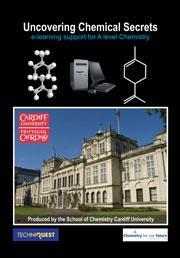Penny Bagshaw reviews this e-learning organic chemistry resource
Uncovering Chemical Secrets: e-learning support for A level Chemistry
DVD
Cardiff University School of Chemistry 2010 | £30.00 |
Reviewed by Penny Bagshaw

This e-learning resource grew from a full-day workshop for A-level chemistry students, developed by the School of Chemistry at Cardiff University in association with Techniquest. It could equally well be used by teachers and students as a stand-alone enrichment activity.
The content is based on the organic chemistry of a range of natural products from plant sources - terpenes and terpenoids, that can be easily extracted and have simple enough structures to be understood by students at this level.
The resource is presented in a clear and attractive way, using a combination of text, photographs, videos and structures, both static and animated. The menu, from which it is easy to navigate and to which it is easy to return at any stage, lists four main sections:
- Background chemistry
- Practical chemistry
- Modern analytical techniques
- Results and analysis
Using selected terpenes and terpenoids as examples, the background chemistry section explores some of the chemistry of alkenes and carbonyl compounds. Clicking on the name of a compound shows its skeletal formula with a clever addition - rolling the mouse over the structure reveals the atoms present at each vertex. Clicking on 'alkene' or 'carbonyl compound' highlights the relevant group in each molecule. Geometrical - including an introduction to E/Z nomenclature - and optical isomerism are introduced with links from relevant examples. Three short quizzes test students' understanding of skeletal and molecular formulas, functional groups and isomerism; there is an instant facility to check answers but students would need teacher support to correct any errors.
The practical chemistry section includes descriptive text and annotated videos of steam distillation, solvent extraction and qualitative tests such as bromine water to detect alkene double bonds and iron( III ) chloride to detect phenols.
Analytical techniques, including liquid and gas chromatography, mass spectrometry, IR and NMR spectroscopy, are introduced by text illustrated with photographs, diagrams and animations, togther with clips from the RSC's videos. This section, while clearly presented with lots of visual material, would probably be least appealing to students.
The results and analysis section refers to compounds extracted during the workshop, including chromatographs and annotated spectra obtained from orange and lemon, clove, lemongrass, peppermint and spearmint. Teachers will always be keen to collect such examples of real spectra, even if this section is less useful as a stand-alone.
Also on the disk are Word documents detailing the reagents required for the practical workshop and a printable booklet (available in both English and Welsh), presumably given to workshop participants.
Teachers might use this resource in planning a practical activity to be done in their own schools, or as enrichment/reinforcement of their organic chemistry teaching. It would be most useful during an A2 course when students had already encountered ideas about spectroscopy. Students might enjoy using it to revise some organic chemistry, or as a resource to help in planning a Salters Individual Investigation or an Extended Project.






No comments yet